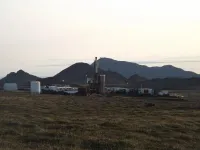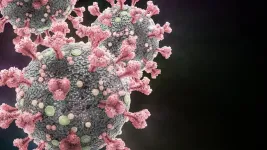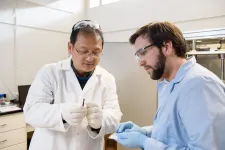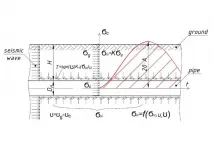Differences in national food security best explained by household income, not agriculture
Dartmouth Engineering study published in Food Security
2021-04-16
(Press-News.org) One of the most comprehensive statistical analyses of drivers of food insecurity across 65 countries has concluded that household income consistently explains more discrepancy in food security than any other factor, including agricultural land resources and production. The Thayer School of Engineering at Dartmouth study, "Cross-national analysis of food security drivers: comparing results based on the Food Insecurity Experience Scale and Global Food Security Index," was recently published by the peer-reviewed journal Food Security.
Given the persistent issue of food insecurity--one of the United Nation's sustainable development goals is to achieve zero hunger--the study's results are vital in determining how best to tackle the complex problem.
"We're trying to inform international development efforts. There's a long history of rich countries launching initiatives to help the developing world which aren't very effective," said co-author Lee Lynd, the Paul E. and Joan H. Queneau Distinguished Professor of Engineering at Dartmouth. "If the real reason people are food insecure is that they're poor, the best thing you may be able to do for them is to give them a job."
"When we took a data-driven look at this, we found that the amount of money that households were actually spending on goods and services was by far the most important determinant of food security amongst the countries that we studied," said first author Andrew Allee, Dartmouth Engineering PhD candidate.
At the cross-national level, the study concludes quantity and quality of a nation's agricultural land were not predictive of national food security, and instead, the most effective strategies to improve food security will include measures to increase citizens' capacity for consumption. The researchers are quick to point out that no single metric can capture all dimensions of food security, but the models consistently showed that household spending, measured as per-capita household final consumption expenditure, was the single best predictor of food security, meaning an increase in income usually drives an increase in food security.
Allee and Lynd worked with Vikrant Vaze, the Stata Family Career Development Associate Professor of Engineering at Dartmouth, on linear regression models which used country characteristics to predict food security from the Food Insecurity Experience Scale and the Global Food Security Index, two well-known indicators of food insecurity. The 65 countries studied represent 56 percent of the global population.
INFORMATION:
Allee's research was supported in part by two fellowships he received as a PhD student while at Dartmouth: the Henry J. McCarthy 1931 Fellowship and a National Science Foundation (NSF) Graduate Research Fellowship. Lynd's work is supported by The Center for Bioenergy Innovation, part of the Oak Ridge National Laboratory.
ELSE PRESS RELEASES FROM THIS DATE:
2021-04-16
Boulder, Colo., USA: Volcanologists' ability to estimate eruption risks is largely reliant on knowing where pools of magma are stored, deep in the Earth's crust. But what happens if the magma can't be spotted?
Shane Rooyakkers, a postdoctoral scholar at GNS Science in New Zealand, grew up in the shadow of Mount Taranaki on the country's North Island, hiking on the island's many volcanoes. Today, his research is revealing hidden dangers that may have been beneath his feet all along.
A new study, published yesterday in Geology, explores a threat volcanologists discovered only recently: surprisingly shallow magma pools that are too small to be detected with common volcano monitoring equipment. Such a magma body was ...
2021-04-16
LA JOLLA, CALIF. - April 16, 2021 - Scientists at Sanford Burnham Prebys have identified a set of human genes that fight SARS-CoV-2 infection, the virus that causes COVID-19. Knowing which genes help control viral infection can greatly assist researchers' understanding of factors that affect disease severity and also suggest possible therapeutic options. The genes in question are related to interferons, the body's frontline virus fighters.
The study was published in the journal Molecular Cell.
"We wanted to gain a better understanding of the cellular response to SARS-CoV-2, including what drives a strong or weak response to infection," says Sumit K. Chanda, Ph.D., professor and director of the Immunity and Pathogenesis Program at Sanford Burnham Prebys and lead ...
2021-04-16
Scientists have figured out how to modify CRISPR's basic architecture to extend its reach beyond the genome and into what's known as the epigenome -- proteins and small molecules that latch onto DNA and control when and where genes are switched on or off.
In a paper published April 9, 2021, in the journal Cell, researchers at UC San Francisco and the Whitehead Institute describe a novel CRISPR-based tool called "CRISPRoff," which allows scientists to switch off almost any gene in human cells without making a single edit to the genetic code. The researchers also show that once a gene is switched off, it remains inert in the cell's descendants for hundreds of generations, unless ...
2021-04-16
Look deep inside the brain of someone with Alzheimer's disease, most forms of dementia or the concussion-related syndrome known as chronic traumatic encephalopathy (CTE) and you'll find a common suspected culprit: stringy, hairball-like tangles of a protein called tau.
Such conditions, collectively known as "tauopathies" strike scores of people across the globe, with Alzheimer's alone affecting six million people in the United States.
But more than a century after German psychiatrist Alois Alzheimer discovered tau tangles, scientists still have much to ...
2021-04-16
What The Study Did: The fitted filtration efficiency of commonly available masks worn singly, doubled or in combinations was evaluated in this study.
Authors: Emily E. Sickbert-Bennett, Ph.D., M.S., of the UNC Medical Center in Chapel Hill, North Carolina, is the corresponding author.
To access the embargoed study: Visit our For The Media website at this link https://media.jamanetwork.com/
(doi:10.1001/jamainternmed.2021.2033)
Editor's Note: The article includes conflict of interest and funding/support disclosures. Please see the article for additional information, including other authors, author contributions and affiliations, conflict of ...
2021-04-16
CHAPEL HILL, NC - A study published today in JAMA Internal Medicine shows that wearing two face coverings can nearly double the effectiveness of filtering out SARS-CoV-2-sized particles, preventing them from reaching the wearer's nose and mouth and causing COVID-19. The reason for the enhanced filtration isn't so much adding layers of cloth, but eliminating any gaps or poor-fitting areas of a mask.
"The medical procedure masks are designed to have very good filtration potential based on their material, but the way they fit our faces isn't perfect," said Emily ...
2021-04-16
Thermoelectrics directly convert heat into electricity and power a wide array of items -- from NASA's Perseverance rover currently exploring Mars to travel coolers that chill beverages.
A Clemson University physicist has joined forces with collaborators from China and Denmark to create a new and potentially paradigm-shifting high-performance thermoelectric compound.
A material's atomic structure, which is how atoms arrange themselves in space and time, determines its properties. Typically, solids are crystalline or amorphous. In crystals, atoms are in an orderly and symmetrical pattern. Amorphous materials have randomly distributed atoms.
Clemson researcher Jian He and the international team created a new hybrid compound in which the crystalline and ...
2021-04-16
Russian scientists have proposed a theory of phase transformation in polymer gels. It explains the mechanisms of the dramatic reduction in volume of zwitterionic hydrogels when they are cooled. The results are published in the journal Chemical Communications (ChemComm).
Polymer gels have unusual properties, including the ability to absorb water in volumes hundreds of times greater than their own. For example, some hydrogels are capable of holding up to two kilograms of water per gram of dry gel. By changing the temperature or adding solvents, various desired properties can be achieved. This is why polymer gels are used in industry and biomedicine, including for the targeted delivery of medication, creation of artificial skin, children's toys, etc.
If you take ...
2021-04-16
Two new studies published in Blood suggest that the mRNA COVID-19 vaccine may have reduced efficacy in individuals with chronic lymphocytic leukemia (CLL) and multiple myeloma, two types of blood cancer. According to researchers, these studies could help inform the ideal time for vaccination of these populations.
Study suggests two-dose COVID-19 vaccine is less effective for people with CLL as compared to healthy controls
The first study reports that people with CLL had markedly lower immune response rates to the two-dose mRNA COVID-19 vaccine than healthy individuals ...
2021-04-16
Underground pipelines that transport oil and gas are very important engineering communications worldwide. Some of these underground communications are built and operated in earthquake-prone areas.
Seismic safety or seismic stability of underground pipelines began to be intensively studied since the 1950s.
Since then, a number of methodologies were proposed for calculating stress received by an underground pipeline during an earthquake. The purpose of these methodologies was to make an accurate prediction on the structural stress received by a pipeline during an earthquake, and thus it would allow to decide ...
LAST 30 PRESS RELEASES:
[Press-News.org] Differences in national food security best explained by household income, not agriculture
Dartmouth Engineering study published in Food Security




